How to clean car interior

A clean car interior not only looks great, it is also better for your health and health of your passengers.
This 8-year old Acura in the photo belongs to a friend of mine; it has more than 140,000 miles on the odometer; yet with proper care its interior still looks very good, as you can see. It takes about an hour to clean the entire interior thoroughly. Be careful with water inside the car; if water gets into electrical components, it may cause problems. Similarly, don't soak the seats too much and don't let water to get under the carpet; it could cause corrosion, stains and damp mouldy smell. Make sure to dry the interior well after you done.
|
• Vacuuming• Cleaning fabric seats and door upholstery• Cleaning car leather• Cleaning the carpet• Cleaning and polishing the dashboard• Cleaning the windows• How to get rid of musty smell from air conditioner
Vacuuming

Remove the floor mats. Vacuum the seats and the carpet. Using the proper attachment, reach under the seats, around the pedals and the area between the front seats and the center console. Vacuum floor mats separately.
|

Use a soft brush attachment to vacuum the dashboard, center console and the doors. Be careful not to damage knobs, vents and sticking parts. Use the same attachment vacuuming the seats. Leather seats are very easy to damage, be careful no to scratch them with the vacuum hose.
|
Cleaning fabric seats and door upholstery

Let's see how we can clean this dirty spot on the rear seat.
|

There are number of upholstery cleaning agents available. Here I used the Turtle Wax upholstery cleaner, but other products can work as well.
The first step, spray the cleaner evenly on the upholstery.
|

Rub vigorously. Once the dirty spot is gone, wipe it thoroughly with a dry soft cloth.
|

The dirty spot is gone. You can clean all the seats and door upholstery the same way, working one area at the time. If you don't have a special upholstery cleaner, a regular laundry detergent will work as well: Mix a small amount of the detergent with warm water. Dip a clean cloth into it. Squeeze out well - you want a barely moist cloth. Work harder on dirty areas. When finished, wipe out well with a clean, soft dry cloth.
|
Cleaning car leather
A car leather is very delicate, so it's best to use a good product specially formulated for cleaning leather seats. Some leather care products make the leather more shiny or slippery. Other products can make it sticky or tacky, so before using it, test a product in a small area to see if you like it. Don't use paper towels on leather, they can leave scratches; use a soft clean cotton towel instead.

Be careful with the leather-wrapped steering wheel and shifter knob as some of the leather care products can make them slippery or sticky. I personally don't use any products on my steering wheel and a shifter knob, I just clean them with clean and barely moist cotton towel. If you use any leather care products on your steering wheel, make sure that it is not slippery before you drive.
|

Vacuum leather seat crevices with the soft brush attachment - be careful, as the vacuum hose can easily scratch the leather.
|

Spray some leather cleaner agent on the soft clean cotton towel.
|

Wipe the seat gently, reaching into crevices and around the edges.
Here I used a two-in-one leather cleaner/conditioner. If you have just a cleaner, apply a conditioner later to protect the leather.
Cleaning the carpet

You can clean the carpet the same way you cleaned the fabric seats and upholstery. The laundry detergent solution will work on the carpet as well.
|

Work on one area at the time. Spray the carpet cleaner evenly.
|

Rub well. If your cleaner has a brush on it, you can use it on really dirty areas.
|

When done, wipe it thoroughly with a dry cloth.
|

Again, don't soak the carpet with water too much, it will cause mould smell and corrosion under the carpet. Dry it out as fast as you can.
|
Cleaning and polishing the dashboard and interior plastic

Clean the dashboard, center console and other plastic parts with a barely moist clean cloth. Use a very small amount of laundry detergent to remove the stains. Dry with a clean soft dry cloth. To make it shiny, use a polish for plastic.
|

Spray a little amount of polish. Spread it evenly with a soft brush. Don't spray directly on the stereo, or other electrical parts, use a brush instead.
|

Buff gently with a clean soft dry cloth.
|

This is how it looked before and after polishing. If you prefer the dashboard and the plastic looking less shiny and more natural, there is a number of products that can do that. For example, I like the Meguiar's Natural Shine that makes the plastic look more natural.
|

A good polish not only makes the dashboard look clean and shiny, it shields and protects the plastic. All you need to do after, just use a soft duster periodically and your dashboard will look like new for a long time.
|
Cleaning the windows

Lastly, clean all the windows from the outside and inside. A window-cleaning spray and glass-cleaning towel will do a good job. Be careful when cleaning the rear window from the inside - the heating lines of the defogger grid are easy to damage. Use parallel to defogger lines motion.
|
How to get rid of musty smell from the air conditioner

If you experience that unpleasant musty smell from the vents when the air conditioner is turned on, you can try one of the odor treatment that you can buy in your local auto parts store. It kills the bacteria and removes the mildew smell. Here we used the Air Conditioner Treatment from Wynn's that you simply spray into outside air intake vent (check the directions on the product).
|

A clogged air conditioner drain tube and accumulation of leaves and other debris under the cowl panel also may cause a damp mildew smell. Clean the debris and ask the mechanic to check the air conditioner drain tube when you do your next oil change. The drain tube is usually located under the car on a passenger side, near the firewall.
|
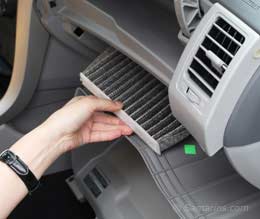
One part that is often gets neglected is the cabin air filter. After a while it gets clogged up with dust, leaves and other debris, so instead of fresh air, you have to breathe with whatever accumulated on the cabin filter. Do you want to see how to replace the cabin filter?
Changing your cabin air filter
Updated: September 24, 2013
Many cars have a cabin air filter that filters outside air coming into the cabin. A cabin air filter is recommended to be replaced every 12 months or 10,000-15,000 miles (16,000 - 24,000 km).
Signs of a clogged up cabin air filter include reduced air flow and bad odor coming from the air vents.
A cabin air filter clogs up faster if your car is parked under trees or if you drive on unpaved roads.
In some cars a cabin filter is easy to replace, in others, it's better to let your dealer have it replaced it for you. Here we are replacing the cabin filter in the 2009 Toyota Corolla:
Replacing the cabin filter in the 2009-2013 Toyota Corolla
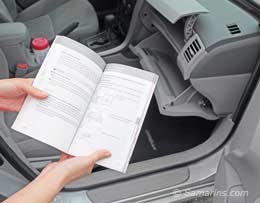
In this car, Toyota made it very simple and provided the instructions in the owner's manual; it is a fairly easy task.
|
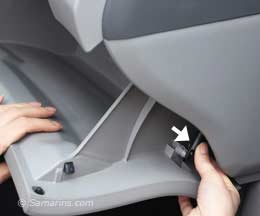
The first step, as per this manual is turn the engine OFF; of course, we don't need it running. The next step, open the glove box, locate the damper and slide it off.
|
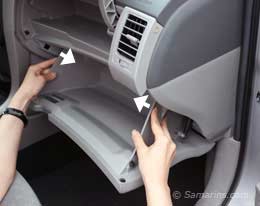
Now, the manual says push in each side of the glove box to disconnect the claws. What it means is there are two claws sticking out on each side (see the next photo); to pass them out of the glove box opening, you need to squeeze the glove box gently from each side.
|
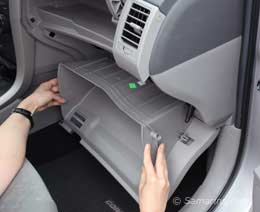
Here you can see the claws we are talking about.
|
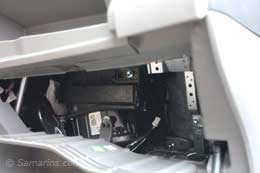
Here is what we got behind the glove box. Click on the photo to see the larger image.
|
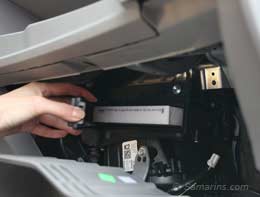
This is easy: remove the filter cover.
|

Pull the old filter out carefully, as it might be filled with leaves and other debris. This one looks dirty.
|
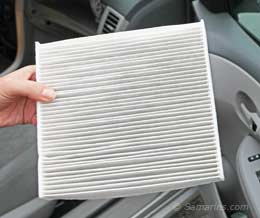
Here is the new cabin air filter we bought from a Toyota dealer.
|
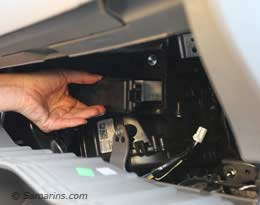
All we need now, is to install everything back in the reverse order. Make sure install the filter the right way. This manual says The "↑UP" marks shown on the filter should be pointing up. Slide the filter back carefully; check if the cover closes properly.
|

Again, push in each side to make the claws go back in.
|
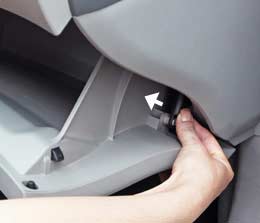
Lastly, push the damper back into its place. Done. At a dealer, this job typically costs from $30 to $70 for labor plus about $20 for a part.
If you want to better filter out odors, you can buy an activated charcoal cabin air filter that better absorbs various smells. We have tried it, it does work better.
|
|
|

























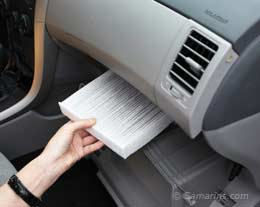









No comments:
Post a Comment